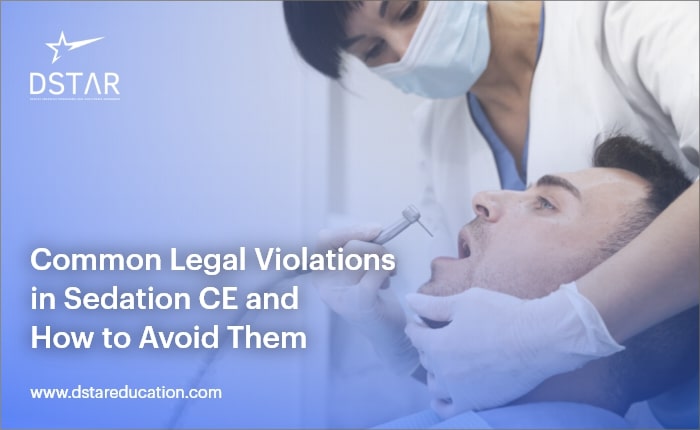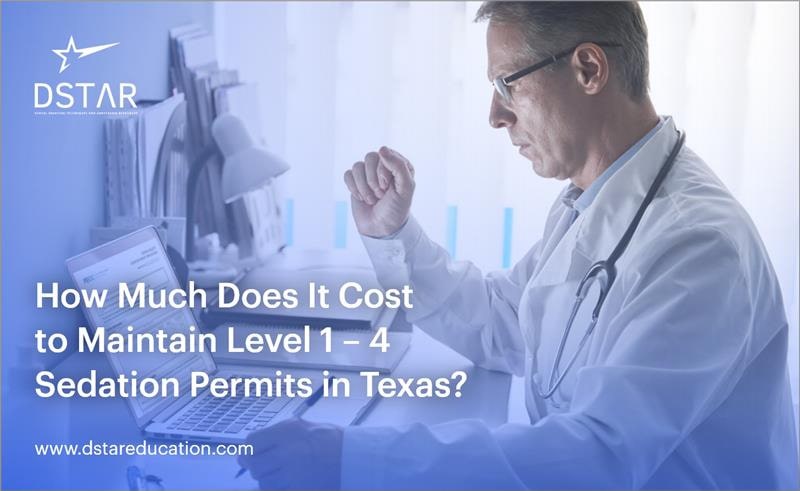Dental sedation continuing education (CE) plays a critical role in ensuring patient safety, professional accountability, and regulatory compliance. Yet, sedation CE violations remain among the most cited issues in Texas and nationwide.
Dentists often overlook key requirements outlined by the Texas State Board of Dental Examiners (TSBDE), the American Dental Association (ADA), and accrediting organizations. These oversights can result in fines, suspension of sedation permits, malpractice claims, and even license restrictions.
This article examines the most common compliance issues in dental CE, explains how sedation CE requirements apply to Texas dentists, and outlines practical steps to avoid violations. By understanding dental CE regulatory requirements and strictly adhering to sedation course compliance guidelines, dentists can minimize legal risks and protect their careers.
1. Overlooking Sedation CE Requirements
One of the most frequent violations involves failing to complete the required number of CE hours for sedation permit renewal. In Texas, dentists with sedation permits must complete specific CE hours tied directly to their permit level (Levels 1–4).
Without meticulous sedation documentation, CE hours may be rejected during random audits, leading to fines, permit suspension, or license restrictions. Since CE audits are conducted randomly by TSBDE, dentists must maintain thorough documentation.
Avoidance Strategy: Maintain a digital and physical log of completed CE hours, including course provider details, dates, and certificates of completion.
2. Enrolling in Non-Compliant CE Programs
Not every continuing education course qualifies under TSBDE standards. Dentists sometimes register for programs offered by non-approved providers, leading to non-recognition of hours during renewal. This directly violates CE requirements.
Corrective Action: Always verify that the CE provider is approved by the Academy of General Dentistry (AGD PACE), American Dental Association (ADA CERP), or directly recognized by the Texas State Board of Dental Examiners, just like DSTAR Education.
3. Failure to Maintain Sedation Compliance During Inspections
TSBDE inspections focus heavily on compliance. Even if dentists complete the required CE, they can still face risks if they fail to implement sedation course compliance guidelines in their daily practice.
For Example, failing to keep updated sedation records, not checking equipment expiration dates, or lacking ACLS/PALS certification represent major violations.
Control Step: Integrate CE learnings into daily clinical practice. A course certificate does not shield a dentist from liability if their sedation protocols remain outdated.
4. Misrepresentation of CE Credits
Some practitioners misreport CE hours, submit falsified certificates, or claim attendance without full participation. Such misrepresentation constitutes fraud and is a violation of CE requirements.
Prevention Measure: Track only legitimately earned CE hours and ensure proper certification from approved providers. Auditors can verify attendance with course providers, making falsification easily detectable.
5. Ignoring Pediatric-Specific CE and PALS Certification
When providing sedation to children, dentists must meet additional CE requirements, including Pediatric Advanced Life Support (PALS) certification. A common violation involves failing to renew or update PALS training while maintaining a sedation permit.
Safeguard: Renew PALS certification alongside ACLS and sedation CE every renewal cycle to maintain pediatric sedation compliance.
6. Incomplete Documentation of Training
Failure to log CE events with dates, provider names, and certificates is one of the simplest but most common violations. Dentists may complete all required CE but lack sufficient documentation to prove compliance during an audit or inspection.
Recordkeeping Protocol: Create a centralized CE compliance binder that includes certificates, course outlines, and provider accreditations. Maintain electronic backups.
7. Exceeding the Scope of Training and Permit Level
Another frequent violation is applying sedation techniques beyond the scope of the sedation permit. For example, dentists holding a Level 1 sedation permit may attempt procedures requiring Level 3 or 4 authorization. This represents a direct violation of their sedation license under TSDBE rules, not CE requirements.
Permit Compliance Action: Review the scope of your sedation permit regularly and align clinical practice strictly with your certified level.
8. Failing to Update Emergency Airway Training
Sedation-related emergencies often involve airway compromise. Dentists who neglect ongoing airway management protocols and training, even after completing CE, face significant compliance risks. TSBDE requires proof that airway training forms part of sedation CE.
Training Compliance Measure: Ensure every sedation CE renewal course includes updated modules on basic and advanced airway management consistent with TSBDE rules.
9. Lack of Awareness of Changing Rules
Sedation CE requirements evolve frequently. Dentists who rely on outdated knowledge or ignore new regulatory requirements risk non-compliance. For example, while not part of sedation CE, Texas now requires CE on opioid prescribing and Human Trafficking Prevention for license renewal.
Regulatory Awareness Step: Subscribe to TSBDE updates and attend CE courses that emphasize new regulatory changes.
10. Failure to Integrate CE Into Daily Risk Management
Completing CE hours without applying the knowledge leaves dentists vulnerable to malpractice claims. Sedation malpractice cases often arise when providers fail to integrate CE-driven protocols into daily operations, resulting in patient harm.
Risk Management Practice: Translate CE learnings into written office protocols, team training, and mock emergency drills.
FAQs
Q1. What are the most common sedation CE violations?
Ans: Failure to complete CE hours, enrolling in non-approved courses, misreporting credits, and failing to maintain updated airway training are among the most frequent violations.
Q2. How do I ensure sedation compliance during inspections?
Ans: Maintain updated CE logs, renew ACLS and PALS certifications, and verify that sedation protocols align with current TSBDE sedation and anesthesia rules.
Q3. What happens if I fail to meet CE requirements in Texas?
Ans: Consequences may include fines, permit suspension, malpractice liability, or license restrictions depending on the severity of the violation.
Q4. Are there special requirements for pediatric sedation?
Ans: Yes. Dentists must hold current PALS certification and demonstrate pediatric-specific CE to remain compliant with TSBDE rules.
Q5. How can I avoid CE violations during audits?
Ans: Keep a compliance binder with certificates, document CE hours accurately, and verify provider approval through ADA CERP or AGD PACE.
Q6. Can malpractice risk related to sedation be reduced?
Ans: Yes. Prevention requires adherence to TSBDE rules, accurate recordkeeping, and applying CE training directly in practice.
Q7. Why are sedation rules stricter in Texas?
Ans: Texas has heightened oversight due to previous adverse sedation events, making strict compliance a critical element of dental practice.
Q8. What is the dental code D9248?
Ans. Dental code D9248 represents Non-intravenous conscious sedation, a technique used to reduce anxiety and pain during dental procedures by administering sedative or analgesic agents not given through an IV. This code is used when the patient remains conscious but is sedated enough to alleviate anxiety and manage pain without becoming unconscious, with the ability to respond to stimuli. Proper documentation, including a narrative, clinical notes, and potentially a provider’s sedation permit, is required for billing and pre-authorization with dental payers.
Q9. What is non- intravenous conscious sedation?
Ans. Non-intravenous (non-IV) conscious sedation involves administering sedative medications through non-IV routes, such as oral pills or inhalation (like laughing gas), to help patients relax and manage anxiety during a procedure while remaining conscious. It is a common alternative to IV sedation for dental treatments and other medical procedures, allowing patients to stay relaxed and comfortable without the use of an IV line.
Conclusion
Sedation and CE compliance violations stem from neglect, misrepresentation, or failure to implement requirements into practice. Dentists must prioritize sedation permit compliance, verify CE provider approval, and remain vigilant about regulatory updates. Avoiding violations requires more than completing hours; it requires disciplined recordkeeping, proactive training, and integration of TSBDE sedation rules into daily operations.
By following these guidelines, practitioners can avoid violations, reduce risks, and uphold the highest standards of safety and professionalism.
References:
- Texas State Board of Dental Examiners – https://tsbde.texas.gov
- Texas Administrative Code – Title 22, Part 5, Chapter 104 & 110
- ADA Guidelines for Sedation and Anesthesia – https://www.ada.org
- Academy of General Dentistry (AGD PACE) – https://www.agd.org
- American Heart Association ACLS/PALS Requirements – https://www.heart.org
- American Academy of Pediatric Dentistry – https://www.aapd.org
- CDC Guidelines for Expired Medical Products – https://www.cdc.gov
 Take Free TSBDE Anesthesia Jurisprudence Practice Exam Now!
Take Free TSBDE Anesthesia Jurisprudence Practice Exam Now!












